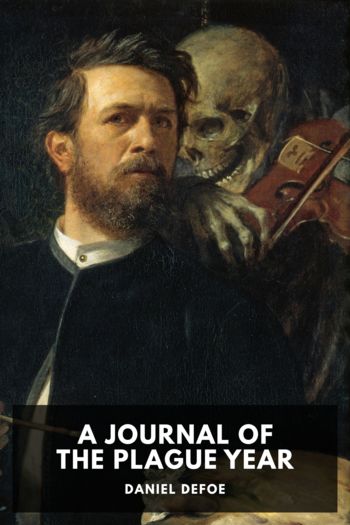Selkirk's Island, Diana Souhami [the best books to read TXT] 📗

- Author: Diana Souhami
Book online «Selkirk's Island, Diana Souhami [the best books to read TXT] 📗». Author Diana Souhami
Light-loving rosette trees grew on low rocks. Three times a year they flowered dark blue. Evergreen myrtles with white flowers graced the forest’s edge, plum trees blossomed in spring. There was brushwood on the rock ledges and lichen on the stones. Luxuriant moss cushioned the boulders at the foot of the waterfalls. Colonies of flowering plants and grasses formed heathland. Herbs thrived by the valley’s streams.
In one valley of green pastures, cut by a fast-flowing stream there was a small harbour where boulders shifted under heavy swell. In calm seas a boat could land at the foot of a projecting rock, hollowed like a tunnel. The rock led to a cave sixteen feet above sea level. It was a place where a man might shelter.*
But only in one wide bay might a large ship find safe anchorage in deep water and its boats reach the shore. This bay was walled by high mountains cut by gulches. The grassland of its valley was screened by sandalwood trees and watered by streams. It was a place of echoes and fragrance: gentle at dawn and dusk, hostile in gusting wind. By its streams grew turnips and radishes, herbs, wild oats and grasses. Behind the valley were high-walled gorges, dense with tree ferns and giant-leaved Gunnera peltata. From these gorges plunged waterfalls. Through thick forest a steep pass led to the south side of the island. At the summit of this pass, after an arduous climb, a man might scan the encircling sea. He would miss no ship that approached The Island. In time this summit became known as Selkirk’s Lookout.
And beyond the valley and before it were ten thousand miles of ocean. The ocean was The Island’s protection. It kept man (Homo sapiens) away. It carried only the daring or the desperate to its rugged, stony shore. Without intervention from man The Island found its times of burgeoning and times of repose.
1702 Seals and Hummingbirds
THE ISLAND served whatever life arrived on it by chance. If not one form then another. Gusting winds brought flies and bees. Plankton survived hurricanes. Spiders and the pupae of butterflies travelled unharmed in driftwood over vast stretches of ocean. Worms came in on the shoes of transient sailors, cats and rats sprang from anchored ships. There were forty-six kinds of mollusc and fifty sorts of fern.
A boa constrictor arrived coiled in the hollow of a cut tree. It had journeyed from Brazil for seven weeks over choppy seas. The tree washed ashore with the turning tide. The snake slithered over the stones of the bay and into the wooded valley. It found food – birds, seal pups, goats – shelter and sunshine, but no company. It sloughed its skin and danced alone.
Living things that reproduced without a partner colonised in a way the boa could not. Seeds survived the digestive tracts of thrushes, they stuck to the feet of albatrosses, they were carried from one part of The Island to another trapped in the fur of mice.
Fur seals (Arctocephalus philippii) with brown coats chose The Island for its stony bays, its deep water close to the shore and for the abundance of its fish. Agile in the sea, they dived and glided and lolled on their backs with folded flippers. On coastal boulders and islets they lumbered and wallowed in the sun. Their wet fur blended with the dark volcanic rocks. At times they appeared to weep. In November they came on shore to breed. Each mother gave birth to a single black-wool-covered pup.
There were huge sea lions (Otaria jubata) twenty feet long with furled snouts. In seasonal ritual to assert mastery they bellowed, fought and gored each other. Scars of sexual battle ringed their throats. The victor fathered a herd.
On every sea-washed rock, crabs scuttled. Beneath these rocks, lobsters grazed. They lived for decades and grew to three feet long. Pike shoaled at the sea’s surface and at night seemed to fly, sand smelt spawned in seaweed, perch lurked near rocks for crabs, bacalao fish bred in deep water by the northern coast, bream scraped algae off the rocks with sharp teeth. There were cod and cavallies and blotched and spotted eels.
Goats came in on Spanish ships. Mariners released a few into the valley by the Great Bay, wanting meat when they careened their ships. The goats were small, dark brown, with curled horns and white marks on their foreheads and noses. They made for the hills and multiplied.
The Island was inhabited. It hosted, protected and sustained its guests. In the undergrowth in the valley were rats (Rattus rattus), mice (Mus musalus), cats (Felis domestica). To all that holed up on it The Island offered sunlight, water, food and shelter. It gave the means of life.
The stars guided in birds. Hummingbirds with copper breasts and tiny pin-like beaks probed nectar from orange flowers. They wove hanging nests in the ferns. A bird that glistened like metal built its nest of moss in the fern groves and laid white eggs. Grey and white petrels swerved over the sea. Flycatchers darted in the valleys. Thousands of pairs of migrating puffins dug burrows in the cliffs. Two black-necked swans arrived, confused by a storm. They lived their life but did not breed.*
The Island was never quiet, never still. There was the chatter and whirr of hummingbirds, the barking of seals, the squealing of rats, the susurrus of waves, the wind in the trees. There were sounds of contentment, of killing and of casual disaster. A nocturnal seabird, the fardela, screamed in the night like a frightened child.
*Classification of The Island’s flora and fauna began in the nineteenth century. There were expeditions by a Scottish horticulturist, David Douglas, in 1824; an Italian botanist, Carlo Bertero, in





Comments (0)